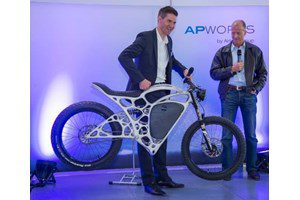 The Light Rider 3D printed motorcycle Simulation software provider Altair and Airbus 3D printing subsidiary APWorks have inked a partnership to advise companies on additive manufacturing (AM), and further down the line, to produce parts for them.
The Light Rider 3D printed motorcycle Simulation software provider Altair and Airbus 3D printing subsidiary APWorks have inked a partnership to advise companies on additive manufacturing (AM), and further down the line, to produce parts for them.
A key area of the collaboration is joint end-to-end consulting by Altair and APWorks to help companies explore the potential of additive manufacturing through pilot projects and technology demonstrators. This includes screening and identification of applications, redesign of components, quantification of potential levels of product performance improvements, printing and physical testing of prototypes up to serial production, and cost analysis and business case preparation.
In a second phase, the offering will also include knowledge transfer to the customer and the adoption of additive manufacturing within its organisation. Another area of collaboration will be to advance Altair’s Software to aim for a simulation-driven design process for printed metal parts that promises to provide a seamless working environment going from design to validation in a very short time and with an intuitive user experience.
“This partnership will help us to support our customers even better,” said Joachim Zettler, managing director of Airbus APWorks. “Our know-how in additive manufacturing and Altair’s expertise in simulation driven design are a perfect combination to help customers truly benefit from the advantages of additive manufacturing.” An early example of the potential of this cooperation is APWorks’ innovation of the world’s first 3D-printed motorcycle, made using APWorks’ Scalmalloy material, weighing in at a svelte 35 kg.
Dr. Robert Yancey, Vice President of Additive Manufacturing for Altair, says: “Topology optimization combined with additive manufacturing will bring about a large range of new products that will be lightweight, efficient, appealing, and sustainable. We are very pleased to partner with an innovative organization like APWorks that is aggressively developing and producing these new products of the future with additive manufacturing.”



